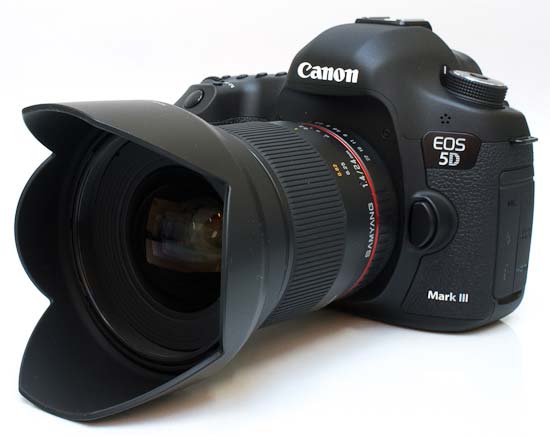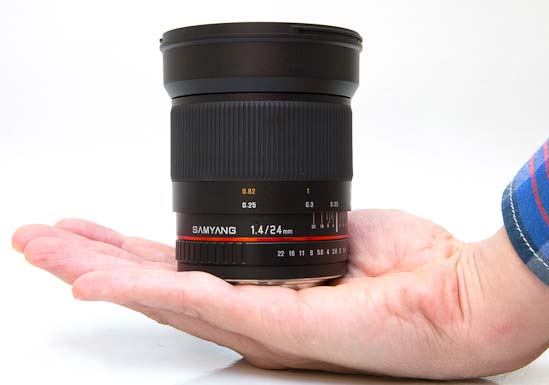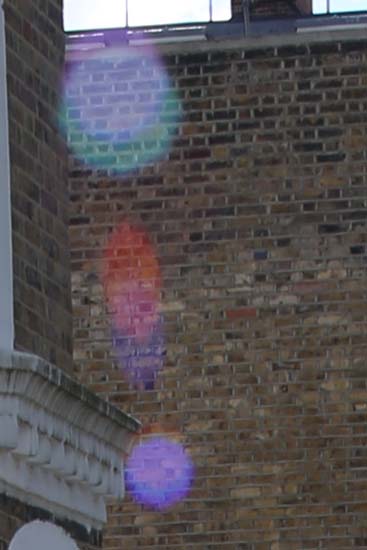Samyang 24mm f/1.4 ED AS UMC Review

Introduction
Announced earlier this year, the Samyang 24mm f/1.4 ED AS UMC is a very fast ultra-wideangle lens for Canon, Nikon, Four-thirds, Pentax and Sony full-frame and APS-C DSLRs and Samsung NX compact system cameras. The Samyang 24mm f/1.4 is a manual focus lens constructed of 13 lenses arranged in 12 groups, with multi-layered and anti-reflexive UMC coatings to help prevent ghosting and flare. The Samyang 24mm f/1.4 ED AS UMC is available now priced at 599 EUR for Canon, Four-thirds, Pentax, Samsung NX, Sony, and 625 EUR for Nikon.
Ease of Use
 The Samyang 24mm f/1.4 ED AS UMC lens
The Samyang 24mm f/1.4 ED AS UMC lens
 The Samyang 24mm f/1.4 ED AS UMC lens, isometric view
The Samyang 24mm f/1.4 ED AS UMC lens, isometric view
 The Samyang 24mm f/1.4 ED AS UMC lens, isometric view
The Samyang 24mm f/1.4 ED AS UMC lens, isometric view
For such a fast and ultra wideangle prime, the Samyang 24mm f/1.4 ED AS UMC is predictably big and bulky, measuring almost 10cms in length and wighing in at 680g. While you can use it on a smaller APS-C body or even Samsung NX body, it won't balance very well - as demonstrated by the images above, it's a much better match for a professional-grade, full-frame camera like the 5D Mark III.
 The Samyang 24mm f/1.4 ED AS UMC lens fitted with the supplied lens hood
The Samyang 24mm f/1.4 ED AS UMC lens fitted with the supplied lens hood
Build quality is very good, despite Samyang being a relative newcomer to the lens market. The Samyang 24mm f/1.4 ED AS UMC feels very solid in your hand, even if the outer barrel and the filter thread appear to be made from plastic.
 Front of the Samyang 24mm f/1.4 ED AS UMC lens alongside the EOS 5D Mark III
Front of the Samyang 24mm f/1.4 ED AS UMC lens alongside the EOS 5D Mark III
 Front of the Samyang 24mm f/1.4 ED AS UMC lens
Front of the Samyang 24mm f/1.4 ED AS UMC lens
 Rear of the Samyang 24mm f/1.4 ED AS UMC lens
Rear of the Samyang 24mm f/1.4 ED AS UMC lens
The focusing ring is generously wide and has a ridged, rubberised grip band. As this is a manual focus lens only, there's a distance scale that runs from the closest distance of 25cm to infinity, with a handy depth of field scale for f/4, f/8, f/16 and f/22. There's also a small white dot that appears to be an infrared focus index.
 Front of the Samyang 24mm f/1.4 ED AS UMC lens
Front of the Samyang 24mm f/1.4 ED AS UMC lens
 Rear of the Samyang 24mm f/1.4 ED AS UMC lens
Rear of the Samyang 24mm f/1.4 ED AS UMC lens
 Front of the Samyang 24mm f/1.4 ED AS UMC lens, isometric view
Front of the Samyang 24mm f/1.4 ED AS UMC lens, isometric view
At the base of the lens is an aperture ring, adjustable in 1 stop (1 EV) intervals, which has a definite clicking action. An uncoupled (de-clicked) manual aperture version of the lens is available on special order if your main interest is shooting movies rather than stills.
 The Samyang 24mm f/1.4 ED AS UMC lens, in-hand
The Samyang 24mm f/1.4 ED AS UMC lens, in-hand
The lens is supplied with a detachable petal shaped lens hood, lens caps and soft lens bag. The filter size is 77mm. Focusing is performed internally so the Samyang 24mm doesn't change length and the filter thread doesn't rotate, good news for filter users.
Note that the Canon version that we tested doens't have any electronic contacts for transferring exposure information to the camera body - there is a Nikon AE version available that can do this.
Chromatic Aberrations
Chromatic aberrations, typically seen as purple or blue fringes along contrasty edges, are impressively well controlled with this lens - the examples below show the worst-case scenario.
 |
 |
Flare
Flare is a typical problem with ultrawide lenses, so we were curious to find out how the Samyang 24mm f/1.4 ED AS UMC fared in this respect. As this example shows the multi-layered and anti-reflexive UMC coatings are effective in preventing veiling flare, but it cannot fully eliminate unwanted reflections when shooting against strong backlight.

Light Fall-off
With the lens wide open at f/1.4, you can see some very noticeable light fall-off in the corners. Stopping down helps, although to completely get rid of this phenomenon, you will need to use an f-stop of f/5.6 or smaller.

Macro
The Samyang 24mm f/1.4 ED AS UMC is not a macro lens. The close-focus point is at 25cm from the film/sensor plane. The following example illustrates how close you can get to the subject, in this case a CompactFlash card.
 Close-up performance
Close-up performance
Bokeh Examples
Bokeh is a word used for the out-of-focus areas of a photograph, and is usually described in qualitative terms, such as smooth / creamy / harsh etc. One of the reason to buy a fast lens is to be able to isolate the subject from the background, which is normally very hard to do with an ultrawide lens. Samyang was apparently very much aware of this requirement, as they employed an iris diaphragm with 8 rounded blades for a pleasing rendering of the out-of-focus highlights. Based on what we have seen, we can say that they largely succeeded. Below you'll find some examples, but you are also encouraged to check out our sample images.
 |
 |
 |
 |
Sharpness
In order to show you how sharp this lens is, we are providing 100% crops on the following page.

